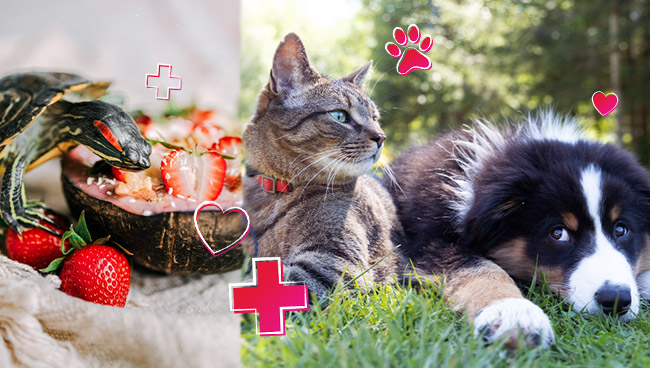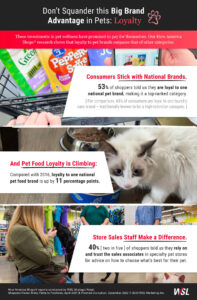The pet category’s foray into wellness is burgeoning, despite rising prices. In fact, brand loyalty in this category outpaces most others. But this exploding category risks facing a challenge common in wellness: confusion due to too many choices and fragmented retail. We sent our Retail Safari® scouts to check out the new pet marketplace.
Retailers, Do You Carry Healthy Choices for Pets?
If not, you might want to consider doing so. The U.S. pet category in 2021 was valued at $125 billion, and it is expected to grow, thanks to its expansion into a range of subcategories, particularly wellness.
We don’t have to look hard to see why. Pets have replaced children for many consumers — 70% of Americans now have pets in their homes, while just 40% have children. All that love and care has been transferred from toddlers to terriers.
And so the pet category is roaring into a multi-channel industry, with pet wellness leading the way. We’ve been watching, and sent our Retail Safari® scouts out to check out pet specialty retailers and brands. Here’s what their ventures reveal.
Consumers Project Their Behaviors Onto Their Fur Babies
Our Retail Safari® scouts tracked the pet category and confirmed that the consumers’ focus on self-wellness has been extended to their pets. Here are some examples of what our scouts saw, which is detailed in our Safari®, “The Big Retail Opportunity: Human Wellness Applied to Pets.”
Vet clinics open at retail.
On-site pet clinics are being added to retail to help pet owners combine several tasks in one trip. At the Petco in San Marcos, Calif., the “Vetco” clinic offers vaccinations, teeth cleaning and spay/neutering. In Germany’s Fressnapf store (translation: “feeding bowl”), pet treatments include dermatology, blood pressure management and surgery.
Human conditions become pet conditions.
Independents set good examples here. The Posh Puppy Boutique, an online seller of pet accessories, is stocking airport vending machines with products that calm travel-anxious pets. However, each pet’s health needs can be unique, so Fressnapf includes a “product finder” monitor where customers can get specific solutions for specific health conditions. At Petco, in-store signage calls attention to specific conditions, such as anxiety.
Personalized menus.
At JustFoodForDogs, New York, in-store chefs prepare a rotating menu of dog meals. In The Pet Market, a small New York chain, customers get personalized pet food recommendations. And Little Creatures of New York sells “real food” treats packaged to look like human snacks (bonus: the “Nooch Puffs” are sustainably made with crickets).
Don’t Squander this Big Brand Advantage in Pets: Loyalty
These investments in pet wellness have promised to pay for themselves. Our How America Shops® research shows that loyalty to pet brands outpaces that of other categories:
Consumers stick with national brands.
53% of shoppers told us they are loyal to one national pet brand, making it a top-ranked category[1]. (For comparison, 43% of consumers are loyal to one laundry care brand – traditionally known to be a high-retention category.)
And pet food loyalty is climbing:
Compared with 2016, loyalty to one national pet food brand is up by 11 percentage points.
Store sales staff make a difference.
40% (two in five) of shoppers told us they rely on and trust the sales associates in specialty pet stores for advice on how to choose what’s best for their pet[2].
Here’s the Risk: Pet Category Overload
These loyalty figures make sense because the pet category is a highly emotional one. However, the expansion into wellness introduces a potentially unhealthy challenge for consumers: too many choices.
Learning from human wellness, we offer these tips:
1. Make the category easier to navigate.
All signage, in-store and online, should designate pet wellness subcategories, such as low-weight formulas, raw foods and special diets. Explaining why these products are beneficial ensures that they’re worth the price premiums. The Pet Market, for example, posts product notes that describe “why we love it.”
2. Stock problem-solving goods in eye-catching places.
Our scouts took notice of dedicated displays of pet treatments. Non-pet chains can borrow from this idea by planting pet products that target acute needs in unexpected spaces, such as near the store pharmacy and online-order pickup areas.
3. Give pet wellness more online prominence.
Our research shows that pet wellness is not merely an emerging subcategory; it’s already arrived. So it should be presented as a dominant category online, using the same elements of education and organized presentation that apply in the aisle. Suggestion: Wellness subscriptions can encourage repeat purchases.
Have a Store Format or Issue You’d Like Explored?
So, retailers, if you don’t yet carry healthy choices for pets, there are options. Curious to learn more? Our Retail Safari® scouts are ready to customize tours to address your challenges and share what your competitors are up to. If you’re ready to explore new categories, channels and innovations, we can help.
You can learn more about what a customized Retail Safari® can do you’re your brand or stores here.



